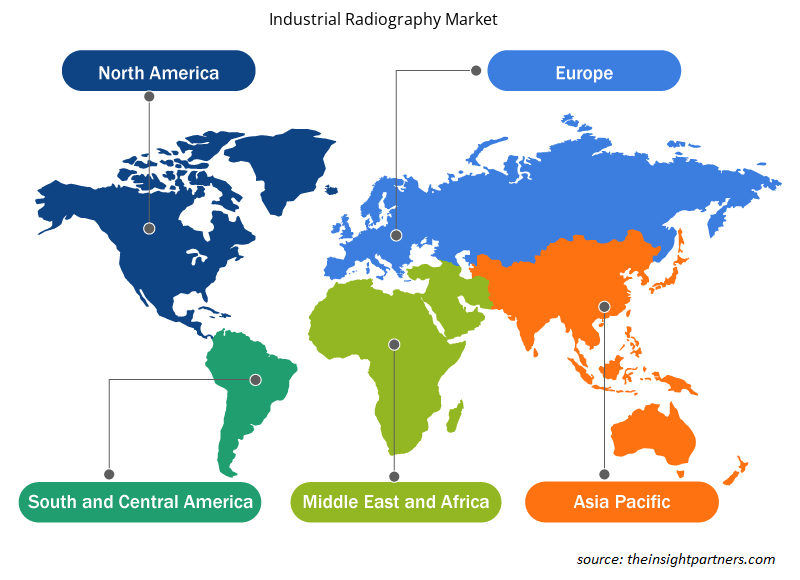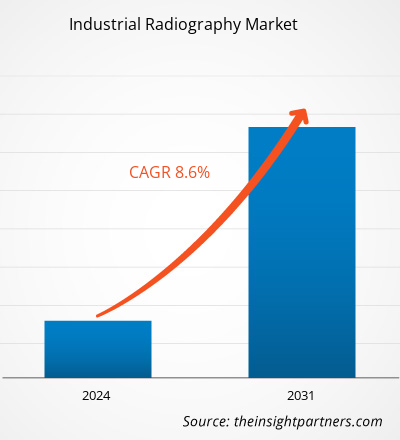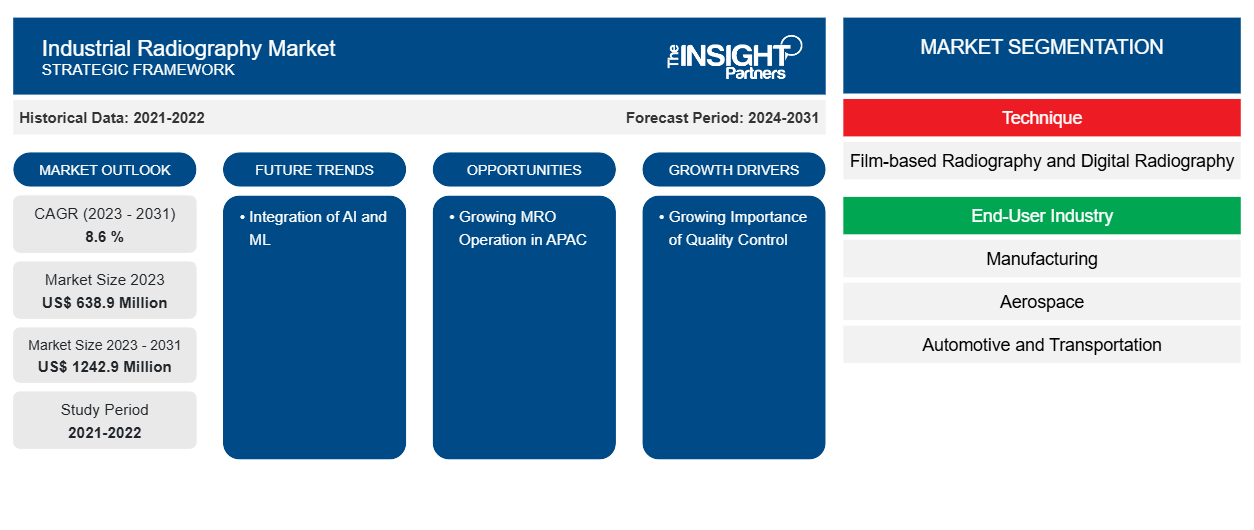工业射线照相市场规模预计将从 2023 年的 6.389 亿美元增至 2031 年的 12.429 亿美元。预计 2023-2031 年期间市场复合年增长率将达到 8.6%。人工智能和机器学习的融合可能仍是市场的主要趋势。
工业射线照相市场分析
在工业射线照相术中,检查员使用电离辐射(例如 X 射线或伽马射线)分析材料和部件的内部结构。这可以让人们发现隐藏的缺陷、测量厚度并检查各种结构的完整性,而不会造成损坏。此外,维护、维修和操作的增加正在推动市场的增长。
工业射线照相市场概况
工业射线照相术是一种无损检测方法,它使用电离辐射检查材料和部件,目的是检测和测量可能导致工程结构损坏的材料缺陷和质量下降。制造商利用工业射线照相术检测材料中的裂缝或缺陷。工业射线照相术主要使用 X 射线和伽马射线来发现肉眼无法察觉的缺陷。工业射线照相术是一种无损物理检测。这种射线照相术使用在受控条件下从放射源发射的电离辐射来检测或确定物体的内部结构,而不会对其外部形态造成任何损害。因此,它可以用来清楚地了解所研究事物或产品的成分或组分。
定制此报告以满足您的需求
您可以免费定制任何报告,包括本报告的部分内容、国家级分析、Excel 数据包,以及为初创企业和大学提供优惠和折扣
-
获取此报告的关键市场趋势。这个免费样品将包括数据分析,从市场趋势到估计和预测。
工业射线照相市场驱动因素和机遇
质量控制的重要性日益提高,有利于市场
工业射线照相的质量控制检查员评估射线图像和检查方法的整体质量。他们保证检查符合行业标准并且设备正常运行。工业射线照相主要用于检测材料和结构的内部缺陷,例如裂纹、空隙、夹杂物和不连续性。它确保众多系统组件的结构完整性和安全性。工业射线照相用于评估金属、聚合物、复合材料和陶瓷等材料。焊缝、管道、铸件、锻件、航空部件和其他物品都是常见的检查对象。
亚太地区 MRO 业务不断增长
印度的 MRO 需求预计将以高于全球平均水平的速度增长,为国内外投资者、OEM 和顶级 MRO 创造机会。国内外投资者均可参与。此外,印度是亚洲最大的 MRO 基地所在地,航空航天业高度集中,劳斯莱斯和空客等大型行业参与者的存在都是亚洲 MRO 业务不断增长的原因。MRO 是许多行业的重要组成部分。以下行业大量使用 MRO 实践:制造企业广泛依赖制造设备、机械和工具的维护和维修活动。这涵盖汽车、飞机、电子产品、消费品和其他行业。运输业包括航空公司、火车、航运和物流,依靠 MRO 技术来维护其汽车、飞机、机车和集装箱车队。
工业射线照相市场报告细分分析
有助于得出工业射线照相市场分析的关键部分是技术和最终用户行业。
- 根据技术,工业射线照相市场分为基于胶片的射线照相和数字射线照相。
- 根据最终用户行业,工业射线照相市场细分为制造业、航空航天、汽车和运输、发电、石化和天然气等。
工业射线照相市场份额(按地区)分析
工业射线照相市场报告的地理范围主要分为五个区域:北美、亚太地区、欧洲、中东和非洲以及南美和中美洲。北美的工业射线照相市场分为美国、加拿大和墨西哥。北美已经发展了航空航天和国防工业气象汽车生产。该地区拥有福特、本田、丰田、特斯拉等多家知名汽车制造商。工业射线照相的主要目的是检测材料和结构中的内部缺陷,如裂纹、空隙、夹杂物和不连续性。制造商使用它来检测产品是否有裂纹或故障。
工业射线照相市场区域洞察
Insight Partners 的分析师已详细解释了预测期内影响工业射线照相市场的区域趋势和因素。本节还讨论了北美、欧洲、亚太地区、中东和非洲以及南美和中美洲的工业射线照相市场细分和地理位置。

- 获取工业射线照相市场的区域特定数据
工业射线照相市场报告范围
| 报告属性 | 细节 |
|---|---|
| 2023 年的市场规模 | 6.389 亿美元 |
| 2031 年市场规模 | 12.429 亿美元 |
| 全球复合年增长率(2023 - 2031) | 8.6% |
| 史料 | 2021-2022 |
| 预测期 | 2024-2031 |
| 涵盖的领域 |
按技术分类
|
| 覆盖地区和国家 |
北美
|
| 市场领导者和主要公司简介 |
|
市场参与者密度:了解其对商业动态的影响
工业射线照相市场正在快速增长,这得益于终端用户需求的不断增长,而这些需求又源于消费者偏好的不断变化、技术进步以及对产品优势的认识不断提高等因素。随着需求的增加,企业正在扩大其产品范围,进行创新以满足消费者的需求,并利用新兴趋势,从而进一步推动市场增长。
市场参与者密度是指在特定市场或行业内运营的企业或公司的分布情况。它表明在给定市场空间中,相对于其规模或总市场价值,有多少竞争对手(市场参与者)存在。
在工业射线照相市场运营的主要公司有:
- 3DX 射线
- 安立公司
- 彗星集团
- 富士胶片公司
- 通用电气
- 梅特勒-托利多
免责声明:上面列出的公司没有按照任何特定顺序排列。

- 了解工业射线照相市场主要参与者概况
工业射线照相市场新闻和最新发展
工业射线照相市场通过收集一手和二手研究后的定性和定量数据进行评估,其中包括重要的公司出版物、协会数据和数据库。工业射线照相市场的一些发展情况如下:
- 英国皇家空军已授予 3DX-Ray 一份合同,为其提供三台 ThreatScan-LSC 便携式 X 射线扫描系统 (RAF)。ThreatScan-LSC 将取代现有系统,这是 3DX-Ray 与英国皇家空军签订的第一份合同。
(来源:3DX-RAY,2021 年 1 月)
- 高性能 X 射线成像提供商 Teledyne Industrial X-Ray Solutions 推出了基于我们创新的抗辐射 IGZO 传感器技术的高速、高性能工业动态探测器新产品系列。Rad-Xcam 1717、1723 和 3030 探测器旨在满足工业检测、生物医学和科学应用的苛刻需求,提供引人注目的集成成本优势。(来源:Teledyne.,2023 年 7 月)
工业射线照相市场报告覆盖范围和交付成果
“工业射线照相市场规模和预测(2021-2031)”报告对市场进行了详细的分析,涵盖以下领域:
- 工业射线照相市场规模及全球、区域和国家层面所有主要细分市场的预测
- 工业射线照相市场趋势,以及驱动因素、限制因素和关键机遇等市场动态
- 详细的 PEST/波特五力分析和 SWOT 分析
- 工业射线照相市场分析涵盖主要市场趋势、全球和区域框架、主要参与者、法规和最新市场发展
- 行业格局和竞争分析,涵盖市场集中度、热图分析、知名参与者以及工业射线照相市场的最新发展
- 详细的公司简介
- 历史分析(2 年)、基准年、预测(7 年)及复合年增长率
- PEST和SWOT分析
- 市场规模、价值/数量 - 全球、区域、国家
- 行业和竞争格局
- Excel 数据集
近期报告
客户评价
购买理由
- 明智的决策
- 了解市场动态
- 竞争分析
- 客户洞察
- 市场预测
- 风险规避
- 战略规划
- 投资论证
- 识别新兴市场
- 优化营销策略
- 提升运营效率
- 顺应监管趋势























 获取免费样品 - 工业射线照相市场
获取免费样品 - 工业射线照相市场